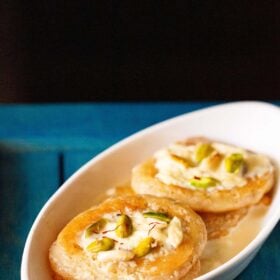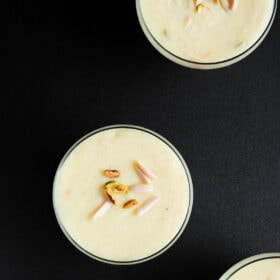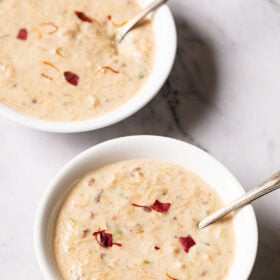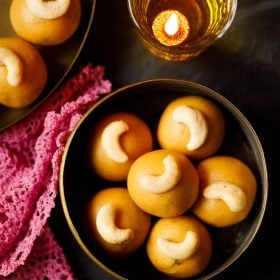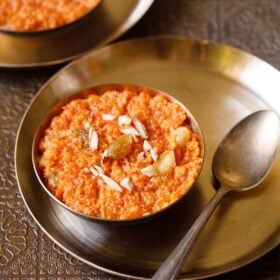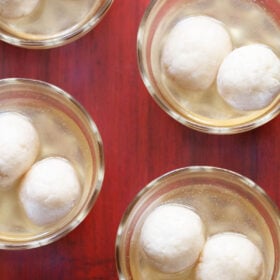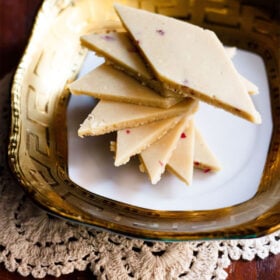Shahi Tukda is a rich, royal and popular dessert from the Mughlai Cuisine. It is made of ghee fried bread slices that are soaked in rose & cardamom scented sugar syrup which are topped with fragrant, creamy, sweetened, thickened milk (a.k.a rabdi) that is flavored with exotic saffron. This decadent sweet is garnished with nuts like almonds, pistachios, cashews and sometimes even edible silver leaf (varak). Give your guests the royal treatment with this unparalleled Indian sweet of Shahi Tukra.
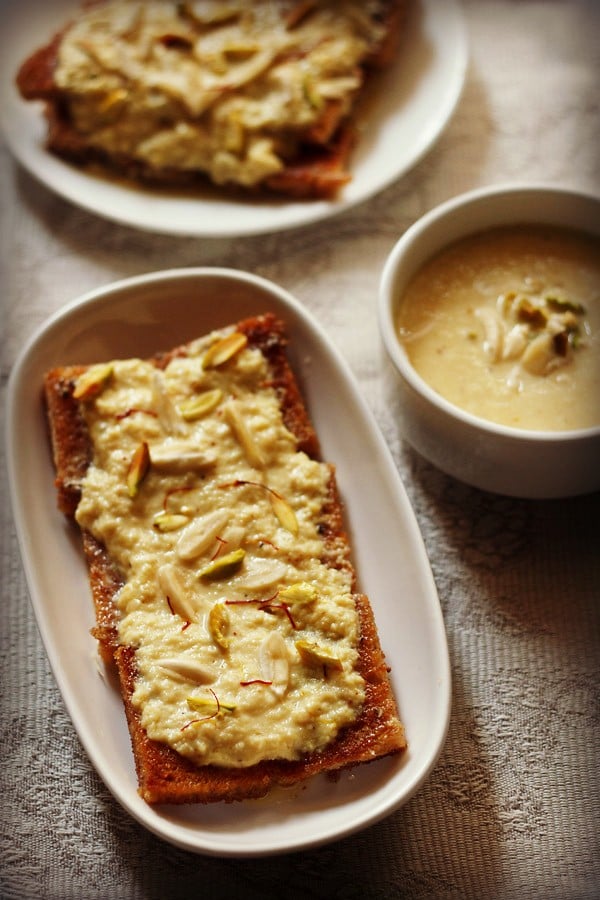
Table of Contents
What is Shahi Tukda
One bite of my traditional recipe of Shahi Tukda will give you a feeling of royalty. It’s no surprise, either!
In Hindi and Urdu languages, the term shahi means “royal” and tukra (also spelled tukda) means “a piece”. Literally translated, this tasty dessert means “royal piece.” (Tukray or tukday is the plural form).
This indulgent sweet is also known as Shahi Toast as is usually made and served on festivals and special occasions.
Shahi Tukda (which is sometimes confused with the Indian bread pudding, Double ka meetha) has been a popular request from my readers, so I’m excited to share this recipe with you.
I learned to make Shahi Tukda recipe in my cooking school. We learned the traditional preparation for this rich royal Mughlai dessert; of course, nowadays there are plenty of quick and easy versions of Shahi Tukra.
Simply put shahi tukra are toasty ghee fried bread slices coated with sugar syrup that are topped with thickened sweetened milk a.k.a rabri and nuts. Easy, right?
Shahi Tukda Recipe Elements
Below I list the main components and elements that you need to make and assemble later to make this royal dessert. Of course you can prep ahead some of the elements like rabri and sugar syrup.
1. Fried Bread
The bread is usually deep fried in ghee. Since I wanted to share an authentic shahi tukda recipe, I have remained 90% true to the traditional method. The remaining 10% is for a step which I have altered for my own benefit.
Instead of deep frying the bread in ghee, I simply pan fried all the bread with only two tablespoons to cut back on calories.
Don’t worry though! This still tastes delicious – if you pan fry the bread really well until it is golden and crunchy, you won’t miss the deep fried version one bit. You could also opt to shallow fry.
I made one more swap to make this traditional Mughlai dessert a little bit healthier – opting for whole wheat bread has more whole grains and fiber than white or milk bread.
2. Rabri
I love to make my own Rabdi by reducing the milk over a low flame, but this process takes time. You have to stir the milk pretty often while its gets reduced; try to do it when you are cooking dinner so it doesn’t feel like a hassle.
I like my rabdi to have a thinner consistency for shahi tukda than when it is served plain or added to kulfi. Feel free to make the rabri with condensed milk similar to Basundi if you’re short on time (or make a Vanilla Custard instead), but nothing beats the original.
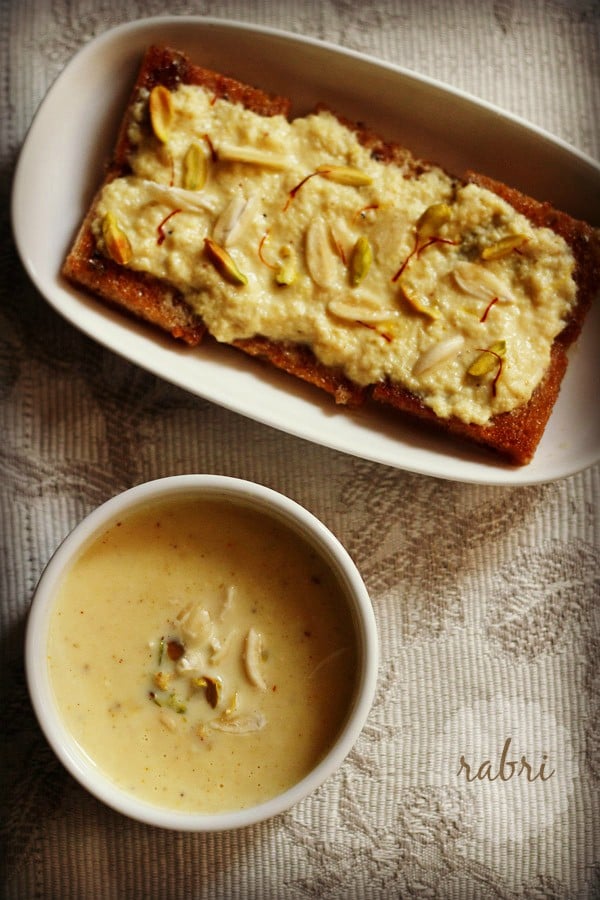
3. Sugar Syrup
The sugar syrup is made simply by cooking sugar with water until the syrup reaches a one thread consistency. If you make it to a thin runny sugar syrup, the bread will absorb all of it making it soggy. A one thread consistency syrup will be sticky and thicker and will coat the bread.
Coating the toasted bread with caramelized sugar syrup flavored with cardamom and rose water takes this dessert to the next level. If you are watching your sugar intake, then skip this step. It still tastes wonderful!
I know this all looks like a lot of steps and preparation, but trust me: once you make the rabri, half the work is done. Mughlai dishes usually demand extensive preparations, but the extra effort is almost always well worth it.
This sweet can be served warm or chilled. If you plan to serve shahi tukra chilled, then you can make the rabri one day before and chill in the fridge.
This is a heavy, rich dessert meant for particularly festive occasions. Whichever festival you are celebrating, this incredible combination of textures and flavors is sure to wow your guests.
How to Make Shahi Tukda
To make it easier to understand, the step-by-step photo guide has been divided into 4 parts:
Prepare the Rabdi (sweet, creamy thickened milk)
Keep in mind that making rabri takes time. To save time you can make this easy and quick Basundi Recipe that has condensed milk. But do make a note of not adding the chironji seeds (charoli) to the basundi.
If you have time, then you can choose to make the rabdi a day ahead. Refrigerate it in an air-tight container.
1. In a broad thick bottomed frying pan or kadai (wok) or a heavy pan take 1 litre of full fat or whole milk and bring to the first boil on medium-low to medium heat.
Keep stirring at intervals so that the milk does not stick to the bottom of the pan.
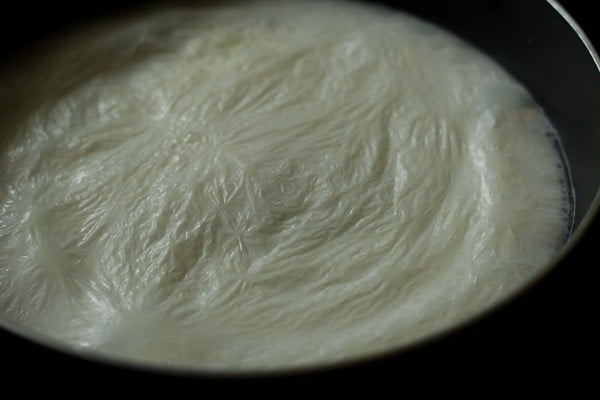
2. Add 3 tablespoons of milk powder ( I used Nestlé brand).
The addition of milk powder reduces the cooking time of rabri, but it is not essential. If you don’t have it, simply cook the milk for longer.

3. Add 1 tablespoon of masala milk powder (this is homemade masala milk powder).
This is another optional step. If you don’t have this masala blend, you can add a pinch of crushed saffron and ¼ teaspoon cardamom powder.
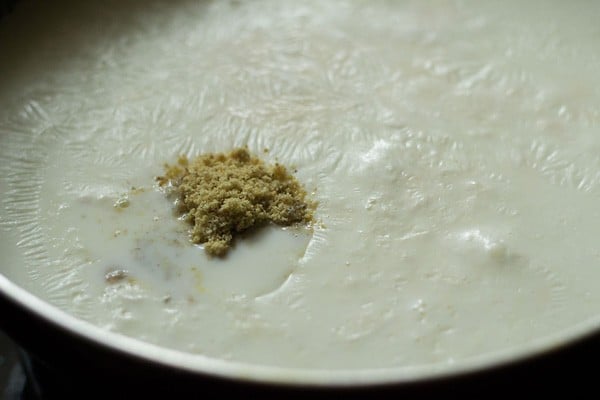
4. Remove the clotted cream (malai) which forms on top of the milk and sides of the pan and stir it back into the milk. Keep on simmering the milk on a low to medium-low heat.
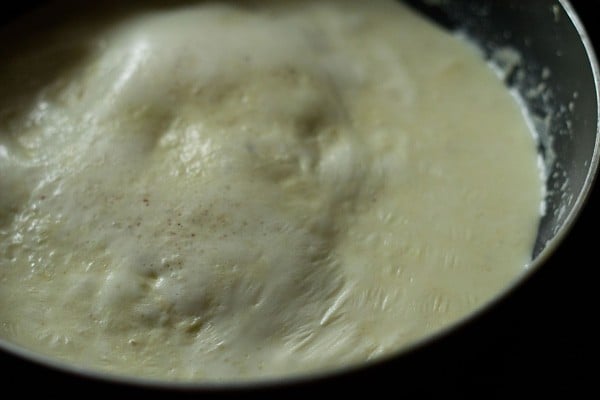
5. Don’t pull the pan off the stove yet – it isn’t ready. Continue scraping the milk solids at the sides of the pan. Also keep on stirring to prevent the bottom or sides from becoming browned or burnt.
Tip: For making dishes like rabri, its always better to use a thick bottomed pan or heavy kadai.
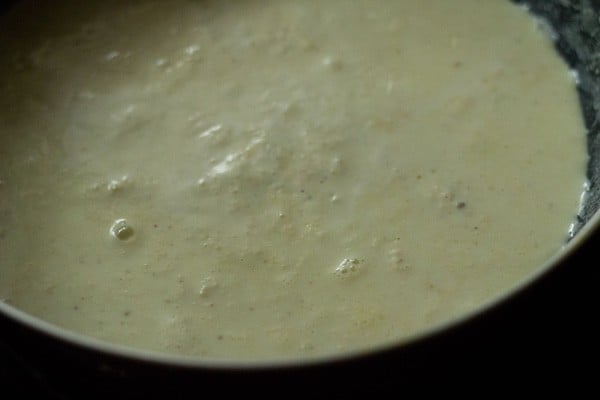
6. On a low to medium-low heat keep on simmering and stirring, returning the clotted cream into the mixture.
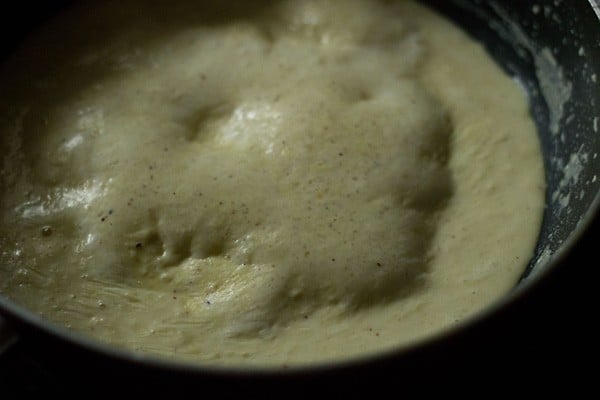
7. Simmer milk until it thickens and reaches to one-third of its original volume. That’s the right consistency as you see in the below photo!
You could also choose to cook it to a less thicker consistency. As it cools, it will thicken more.
It took me about 1 hour. The time may vary depending on the quality of the pan, intensity of flame and quality of milk.

8. Remove from heat and add 2 to 2.5 tablespoons sugar or according to taste. Stir well so that the sugar dissolves.

9. Next add 12 to 15 crushed saffron strands or about 1 to 2 pinches of saffron powder along with kewra (pandanus) water.
You can also add sliced almonds and pistachios here. I did not add as I have already added homemade masala milk powder, which is finely ground dry fruits with a few fragrant spices.
Feel free to substitute kewra water with edible rose water or a few drops of rose essence.

10. The consistency and texture of the rabdi is demonstrated below.
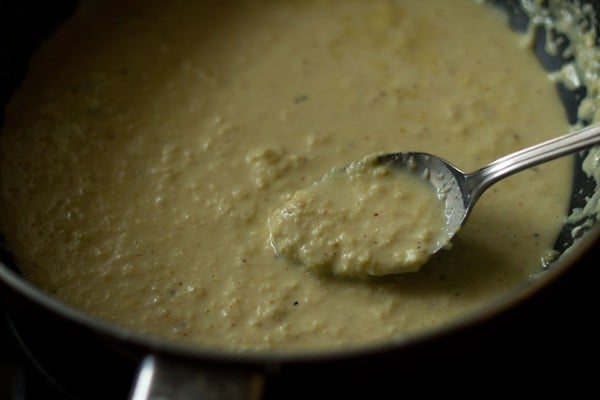
Pan fry bread
1. Slice the crusts of 6 regular-sized bread. Cut them into squares, rectangles or triangles. You could use any bread of your choice – whole wheat, white bread or brown bread.
Opt to deep fry or shallow fry the bread in ghee if you prefer. For a more healthier option you can toast the bread with less ghee on a skillet/tawa/frying pan or in an oven.

2. Heat 1 tablespoon of ghee in a flat skillet (tawa) or a frying pan.
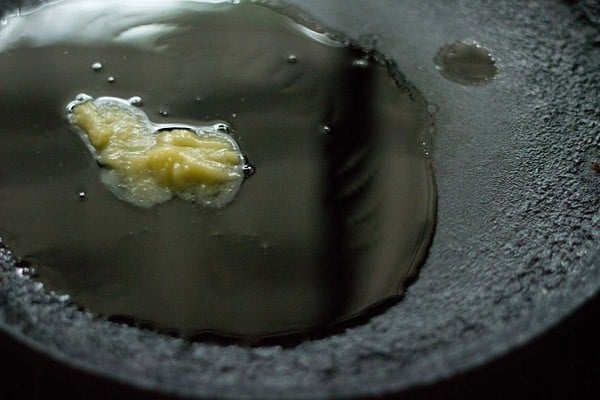
3. Add the bread slices and toast them on a low to medium heat.
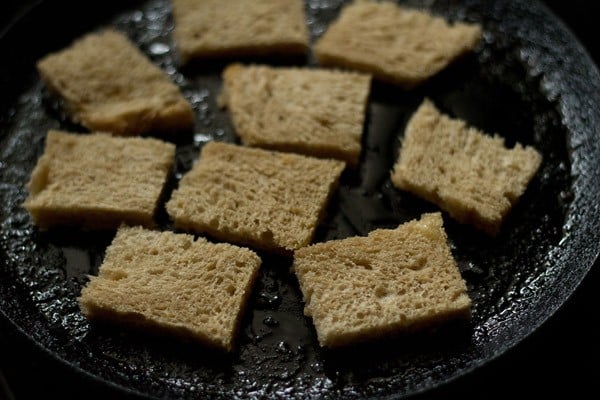
4. When one side is browned till golden, flip and toast the other side.
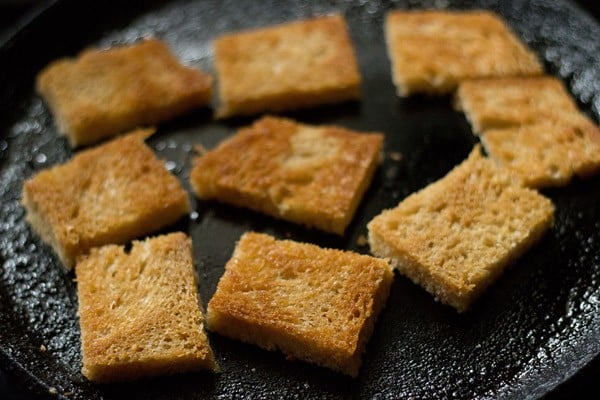
5. Flip once or twice more to get an even golden color and browning.

6. Place the bread slices on paper towels to remove excess ghee.

7. Repeat with another tablespoon of ghee and toast the remaining batch. Keep all the toasted bread side.

Prepare sugar syrup
1. Mix ½ cup sugar with ¼ cup water in a pan.
Time Saving Tip: You can cook both the sugar syrup as well as toast the bread slices, simultaneously.
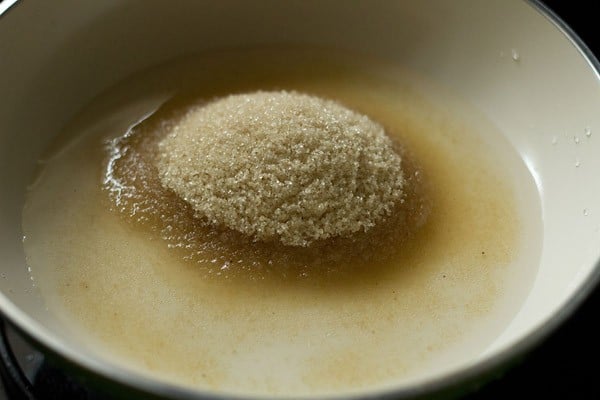
2. Keep the sugar solution on low heat.

3. The mixture should come to a boil.
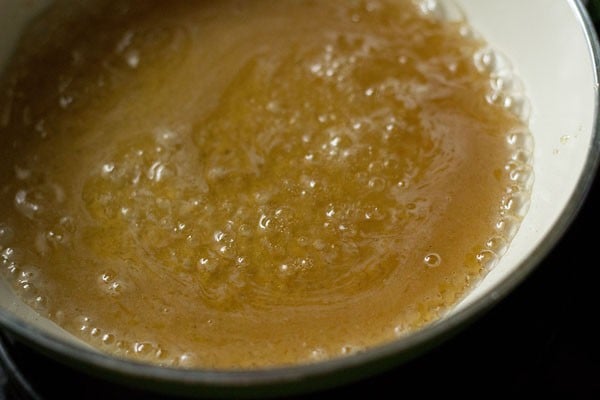
4. When the whole mixture starts boiling like this, it means the one thread consistency is near by. Keep a close watch!

5. One thread consistency is illustrated by using the method below.
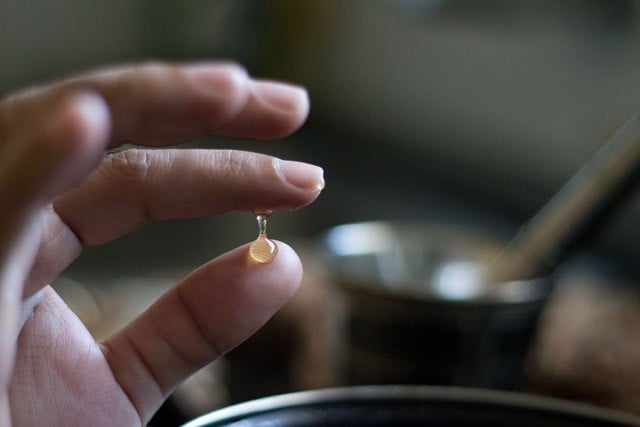
5. Switch off when the one thread consistency is reached. Add cardamom powder or rose water and stir.
If the syrup cools and crystallizes before soaking the bread, then just add about 1 to 1.5 tablespoons water and reheat the syrup over low heat until liquid.
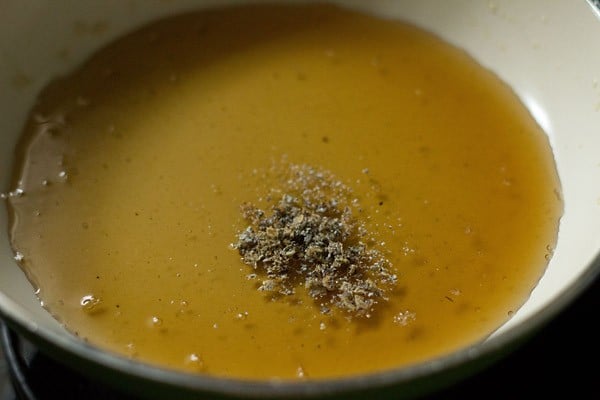
Assemble & Make Shahi Tukda
1. Dip the croutons in the sugar syrup. With the help of a spoon or small tongs, coat the bread slices evenly. The syrup will coat the bread as you flip.
If this is difficult for you, then just pour the sugar syrup evenly on a neatly arranged bed of croutons.
The sugar syrup can be warm or at room temperature when you coat the bread slices or croutons with it.

2. Arrange the sugar coated bread slices neatly in a serving tray or plate.
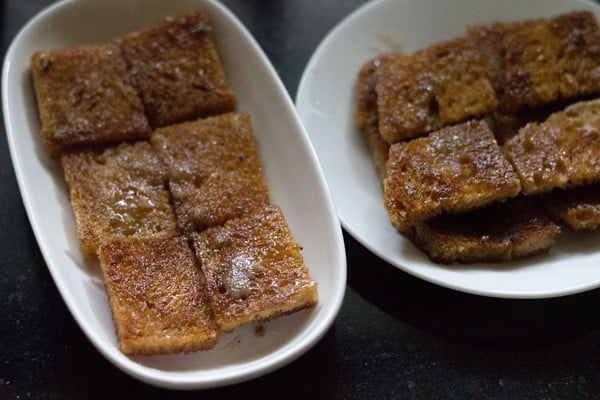
3. Pour the rabri on the syrup soaked bread. Garnish with blanched sliced almonds and pistachios.

4. Serve the rich royal Shahi Tukda as a dessert when you have something worth celebrating. Enjoy!
Keep any leftovers in the refrigerator in a covered container for about a day only. Shahi Tukra or Shahi Toast also tastes good when served cold.
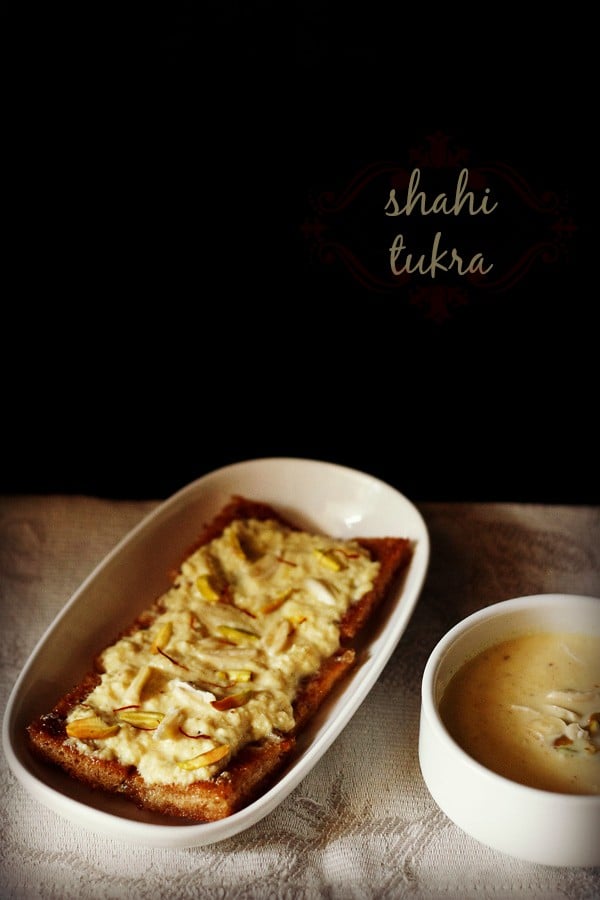
Expert Tips and Variations
- Bread: Feel free to use white bread, brown bread or whole wheat bread. It is better to use a few days old bread so that the bread does not absorb too much of ghee while pan-frying. It is also faster and easier to toast a few days old bread with just a bit of ghee. Please don’t use seed bread or bread crusted with oats.
- Ghee: You could also simply toast the bread slices without any ghee. I would not recommend using any other fat or oil as you will miss on the original authentic taste of this classic sweet. Try to use desi ghee or homemade ghee or a good quality of ghee.
- Nuts: Mostly the nuts that we use are blanched almonds and pistachios. But you could use nuts that are easily available to you. Remember to chop or slice them before topping the sweet. You can omit blanching of the nuts.
- Milk: To make the rabri, always use whole milk or full-fat milk. You can use pasteurized and homogenized milk also.
- Sugar syrup: Ensure that your sugar syrup is cooked to 1 string consistency. It should not be less or more than that. The bread slices will absorb runny and thin syrup making them soggy and you don’t want that. A sugar syrup with a 1 string consistency coats the bread and the slices don’t become soggy or fall apart.
FAQs
YES! If not serving shahi tukda immediately, then keep all components separately in the fridge. Just note that the bread will become a bit soggy after time in the moist air of a refrigerator, so you may want to toast them again before serving.
Some people like to add decorative silver foil (chandi ka varak) to their shahi tukra or shahi toast. If you wish to use it, then place it at the time of serving, regardless of whether you plan on serving it chilled, warm or at room temperature.
I personally made the rabri, sugar syrup and toasting the bread all simultaneously, as I wanted to serve the shahi tukra warm. If the rabri cools down or you make it ahead of time, then just warm it. This dessert is also good chilled or at room temperature, if you prefer.
I’ve heard some people use honey instead, though this will change the flavor profile of the dessert.
More Celebration Sweets!
Sweets Recipes
Sweets Recipes
Sweets Recipes
Sweets Recipes
Please be sure to rate the recipe in the recipe card or leave a comment below if you have made it. For more vegetarian inspirations, Sign Up for my emails or follow me on Instagram, Youtube, Facebook, Pinterest or Twitter.
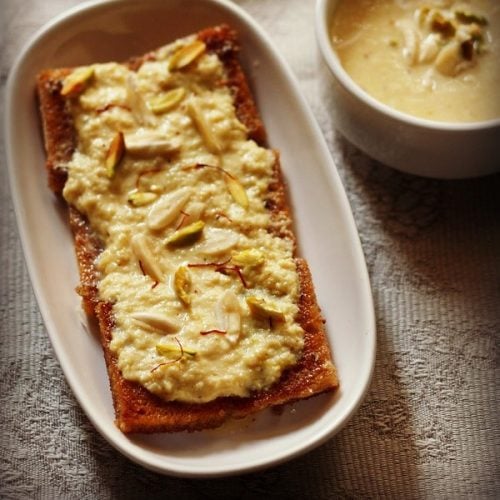
Shahi Tukda Recipe | Traditional Shahi Tukra Sweet
Ingredients
For rabri
- 1 litre whole milk
- 2 to 2.5 tablespoons sugar or as required
- 3 tablespoons milk powder or dairy whitener, optional
- ¼ teaspoon green cardamom powder
- 1 tablespoon masala milk powder – optional
- 1 teaspoon kewra water (pandanus water) or 1 teaspoon rose water or a 1 to 2 drops of kewra essence or rose essence
- 12 to 15 saffron strands or 1 to 2 pinches of saffron powder
For sugar syrup
- ½ cup sugar
- ¼ cup water
- ¼ teaspoon cardamom powder or 3 to 4 green cardamoms powdered in mortar pestle or 1 teaspoon rose water or a drop of rose essence
For pan frying bread
- 6 slices bread – white or brown or whole wheat or milk bread
- 2 tablespoons Ghee (clarified butter) – 1 tablespoon for frying each batch of bread, add more if required
For garnish
- 12 to 15 almonds – blanched and sliced
- 12 to 15 saffron strands – optional
- 10 to 12 pistachios – blanched and sliced
Instructions
Blanching nuts
- First heat a cup of water till it begins to boil in a microwave or stove top or electric heater.
- Add the pistachios and almonds to the hot water.
- Cover and keep aside for 30 mins. Then peel both and slice or chop them. Set aside.
Making rabri
- In a broad thick bottomed pan or sauce pan or a kadai take the whole milk and bring to a boil. Stir the milk a few times when it is coming to a boil, to avoid it from getting browned or stuck to the pan.
- Then add milk powder (I used nestle brand) . The addition of milk powder reduces the cooking time of rabri. Milk powder is not essential and if you don't have then also it is fine. Just that you will have to simmer the milk for some more minutes.
- Add masala milk powder. Again optional and if you don't have just add a pinch of crushed saffron and ¼ teaspoon cardamom powder.
- Remove the clotted cream or malai which forms on top of the milk and add it back to the milk. Also keep on scraping the dried milk from the sides and add them back to the milk.
- Do stir and scrape often so that the milk does not get browned or burnt from the bottom as well as the sides.
- Keep on simmering, stirring, removing the clotted cream and scraping.
- Switch off when the milk has reduced to one-third of its original volume and become thickened.
- Add sugar. Stir well so that the sugar dissolves.
- Next add crushed saffron and kewra water (pandanus water) or rose water. Skip this step, if you have added saffron earlier. You can also add sliced almonds and pistachios here. I did not add as I have already added homemade masala milk powder, which is finely ground dry fruits with a few fragrant spices.
- It will take about 1 hour for the milk to thicken on a low to medium-low heat.
Pan frying bread
- Slice the crusts of the bread. Cut them into squares, rectangles or triangles.
- Heat 1 tablespoons of ghee in a flat pan, tava or frying pan.
- Place the bread slices and on a medium-low to medium heat toast them.
- When one side is browned, flip and toast the other side.
- Flip once or twice more to get an even golden color and browning.
- Drain the bread slices on paper towels.
- Add 1 tablespoon ghee again and toast the remaining batch. Keep all the toasted bread side.
Making sugar syrup
- Mix sugar with in a pan. You can begin with the sugar syrup when you start to toast bread slices.
- Keep the sugar solution on a low heat.
- The mixture would start to come to a boil.
- Cook till you get a one thread consistency in the sugar syrup.
- Switch off the heat, when one thread consistency is reached in the sugar syrup. Add cardamom powder and stir.
- In case the syrup cools and crystallizes before you soak the bread in it, then add about 1 to 1.5 tablespoons of water and reheat the syrup until lightly hot.
Making shahi tukda
- Now dip the bread slices in the sugar syrup. With the help of a spoon or small tongs, coat the bread slices evenly with the sugar syrup. If this is difficult for you, then just pour the sugar syrup evenly on a neatly arranged bed of bread slices.
- Arrange the sugar syrup soaked bread slices neatly in a serving tray or plate.
- Pour the rabri on the sugar syrup coated bread slices.
- Garnish with sliced blanched almonds and pistachios.
- Serve the rich royal Shahi Tukda.
- If not serving shahi tukda immediatedly, then keep in the fridge in a covered container. If you plan to add silver foil (chandi ka varak) then place it at the time of serving, whether serving shahi tukra chilled or warm or at room temperature.
Notes
- Bread: White bread, brown bread or whole wheat bread can be used. It is better to use a few days old bread so the bread slices do not absorb a lot of ghee while pan-frying. Also, it is faster and easier to toast a few days old bread with just a bit of ghee. Please don’t use seed bread or bread crusted with oats.
- Ghee: Do use homemade ghee or desi ghee or a good brand of ghee. You can choose to toast the bread slices without any ghee. I would not suggest using any other fat or oil as these won’t give you the authentic taste.
- Nuts: We always add blanched almonds and pistachios, but you do opt to use nuts that are easily available to you. Remember to chop or slice them. Skip blanching the nuts if you prefer.
- Milk: Use whole milk or full-fat milk to make rabri. You can also use pasteurized and homogenized milk.
- Sugar syrup: Make sure that the sugar syrup is cooked to a 1 string consistency. If you cook it less and if the syrup is runny and thin the bread will absorb it and turn soggy. A sugar syrup with a 1 string is sticky and coats the bread slices.
- Rabri: Making rabri takes time. You can choose to prep it a day ahead and refrigerate. To save time make this Basundi Recipe made without condensed milk. Do not add the chironji seeds if you make this basundi recipe for the shahi tukda.
Nutrition Info (Approximate Values)
This Shahi Tukda recipe post from the archives first published in July 2014 has been updated and republished on March 2023.
